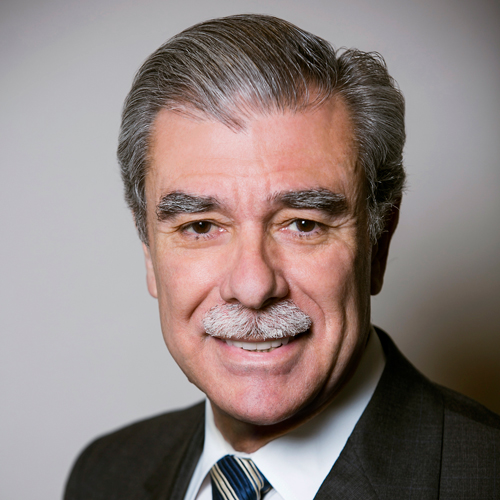What drew you to the field of sociology, and particularly, studying Hispanics?
An internship for the state of Michigan changed my life when I witnessed firsthand the unintended consequences of social policy. In 1972 new housing regulations to reduce crowding resulted in a shortage of homes. Migrant workers who had traveled 2,000 miles to pick berries were being turned away [from housing], and growers were losing their pickers. The experience of solving social problems was riveting for me because I had to roll up my sleeves and face issues that resonated with my own upbringing.
Your childhood was filled with struggle. How did you overcome the economic and personal setbacks?
In my home we didn’t have many books because we were quite poor. I had to work hard but always managed to find mentors along the way, and I am in their debt. My parents had third-grade educations but instilled in us the need to excel. On her deathbed, my mother asked my father to promise her that all of her children would graduate from high school—something both my parents had wanted to do.
As a Latina studying Hispanics, did you ever feel you had to defend your work because others might question your neutrality?
No. I’ve tried hard to avoid being defined as a scholar who pursues “the sociology of me” in narrow terms. My research is comparative, as it must be to understand Hispanicity. We can only see how Hispanics are unique—or not—by comparing them with others.
On the contrary, did you ever feel like people expected you to study Latinas?
Initially I did face some pressure to study Latinas. I was mostly opposed to the expectation that I would research women, particularly of Hispanic origin, just because I am a woman. I was more interested in other issues (economic development, how families budget the cost of childbearing, how fertility influences women’s labor market activity). But when someone asked why I wasn’t studying Chicanas, I was adamant about not letting others define my agenda.
Why were you so opposed to researching Latinas?
It was the ‘70s, and I didn’t see “the women’s question” as a men-versus-women problem. The term “feminist” was bandied about with varied meanings from quite radical, anti-men postures to women-get-short-sticks assertions. Having been raised in a very traditional Mexican household (both my father and step-mother were born in Mexico), I didn’t relate to gender issues the way many of my Anglo peers did. Calls for solutions withmen rather than versus men resonated with me. That’s a generalization, of course, but reflects my take on the women’s movement at the time.
What have been some of the most enlightening findings of your research on the Hispanic population of the United States?
In the 1980s I studied the school-to-work transition of Hispanics to better understand why and how they fall behind. The differences in life courses define the racial and ethnic contours of social inequality. I found that African-Americans stayed in school longer than Hispanics, but experienced discrimination in the labor market, so they had higher unemployment. Hispanics dropped out of school at higher rates, but tended to enter the labor market at younger ages than African-Americans—unfortunately at the expense of education. Thus, their early wage advantage flattened out by young adulthood. Whites were staying in school longest and acquiring work experience along the way, so as prime-age workers, they had the highest earnings.Women’s school-to-work transition is a bit more complicated because childbearing affects both school and work decisions. African-American teen moms are more likely than Latinas to stay in school, so young Latina mothers fell behind in their educational attainment.
How is that research still relevant decades later?
The Hispanic population could generate a demographic dividend for the nation, but only if the education gaps are closed. This happened after the baby boom. Boomers benefitted from expansion and democratization of higher education. Those huge educational investments coincided with a period of widely shared prosperity.
What’s stopping investment in Hispanic education?
Hispanics are coming of age in an aging society. That’s important because the resources and funding for seniors and young people differ. Social investments in youth, such as education, are mainly state-funded, but the big-ticket items for seniors are federally funded. Why is this important? Because the federal government can run a deficit. When the economy goes sour, states make drastic cuts in investments necessary to make their youth competitive in the future (pre-school, K-12 education, higher education, etc.). This portends tensions between young and old along racial lines.
What are some of the ways this lack of investment has manifested in schools?
We’re creating the Latino achievement gap via language. Far too many Hispanic children are in programs for so-called English-language learners (ELL). A well-kept secret is that the majority of children in ELL programs are US-born. What’s wrong with that picture? The immigrant youth are kept in ELL programs too long when they ought to be mainstreamed, so they can learn English in the context of math, science, and literature. For students to progress in the US system, English mastery is imperative, not negotiable. I’m grateful ELL programs did not exist when I was in grade school because I would have been segregated and probably not have emerged at the top of my grade. Students will only be as competitive as the challenges they have to face in school, and every year we hold Latino youth back in remedial English programs is a year lost to narrow the achievement gap.
It seems education is the factor you believe is most influential in a person’s socioeconomic destiny. What do your findings suggest for resolution of the science, technology, engineering, and math (STEM) gap?
History shows that the United States can produce the best scientists in all fields, but only with adequate investments in research and development. To be globally competitive, it is essential to improve our educational system and capitalize on the burgeoning Hispanic population. It is important to keep in mind that fertility, not immigration, is the key driver of their growth. As citizens, Hispanic youth are entitled to quality public education, so they can become productive adults and make economic contributions through taxes, innovation, consumption, and participation in political institutions. The private sector has taken notice of Hispanics’ purchasing potential. There is no reason the richest nation on Earth with some of the best universities can’t draw on Hispanic youth to drive future economic growth and innovation.
As an accomplished Latina, do you ever feel the added responsibility to set an example for Hispanic women with your work?
Yes. I learned perhaps a bit late that we never know for whom we serve as role models. My big lesson came when I was a visiting professor at Stanford. After a seminar for the department, two graduate students contacted me to express gratitude because, as they put it, they felt vindicated. Before I gave the seminar, they felt marginalized, as if they did not belong. After the talk they told me that I held my own, and they were inspired because I was like them. I reminded them that I was a sociologist, not a minority in residence, and that they were sociologists in training. Many years later I learned that one of the women in my undergraduate classes was about to drop out until she took my class. She reported that she actually earned a PhD and was an assistant dean at Stanford.
Did you ever feel similar pressures as a working Latina to forego professional goals or dedication for familial obligations because of your culture?
I’ve never really seen my Latinidad as a barrier in the work-life balance. I was lucky that my father never tried to keep me from going away to school, like some Latinas face in their homes. When asked for advice by Latinas facing resistance from their families, I recommend civil disobedience. In this case, the ends justify the means. Balancing family and work is difficult for all women—period. (Whether you’re working in domestic service or as an executive on Wall Street, kids get sick.) There is no blueprint. There are times I look back and wish I had spent more time with my sons. I suppose most professional women have such laments. When young women would ask me how I balanced family and work—especially as a solo mother most of my career—I usually answered that I never asked that question. Otherwise, I would have become paralyzed.

